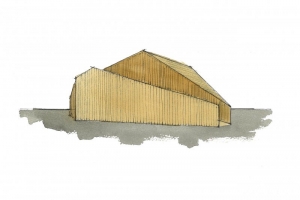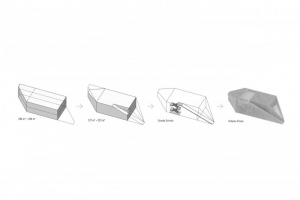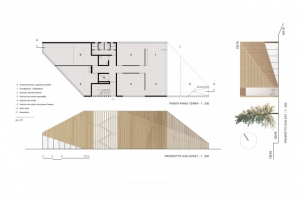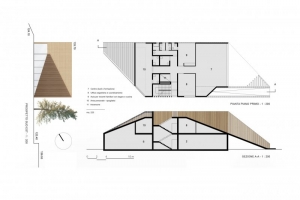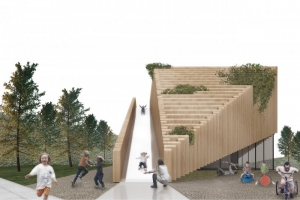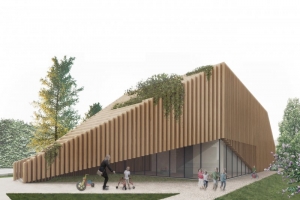“PAVILION CHILDHOOD”
The idea behind this project is simple: to give children with disabilities the largest slide in Milan.
Through its architectural configuration, the toy library (ludoteca) itself becomes an outdoor game, expanding into the park and allowing for a Children’s Pavilion. By allowing children to actively use the building, more socialization can occur and relationships can form.
The toy library ladder leads children to the roof and the top of the Big Slide, an inclined surface measuring 20 meters long and 180 centimeters wide spanning two floors. The Big Slide is completely safe, with a padded interior and guardrails always exceeding 130 centimeters, allowing children and even staff to enjoy a nice ride that gently curves at the end to decrease speed.
The main goal of this project is inclusion of children with disabilities more so that integration. The idea of playing is stressed more than who is playing, making the Big Slide an attraction for all children, not just those with disabilities, although it is designed more with those children in mind.
The Children’s Pavilion will be a place where all children are welcome, brought together by the Big Slide that will be a symbol throughout the whole park for play and acceptance.
The design strategy involves the use of almost the entire ground floor of the rectangular trapezoidal floor plan (277 m²), and a portion of the first floor (223 m²). The Big Slide is located along the south-east wall, and includes a pergola that provides shade for the garden below. This pergola informs the plan of the building, which is symmetrical about its center, allowing for the dimensions and shape of the building to take on a new form. The garden under the pergola naturally extends from the toy library, creating an outdoor play space that can still be seen by staff inside.
In terms of access, the pavilion can be reached by either entering from the south-east through the physical activities room, which also includes the finishes of the other spaces, or by the bay scale.
This access serves a dual purpose by allowing for all the spaces to be used separately while also being mindful of the emergency exit.
From a construction point of view, the building acts as a self-supporting box consisting of cross-laminated timber (such as X-lam). There are several advantages in using this type of technology. The primary advantage with this type of drywall construction, besides being very fast, is the ability to use it as a both a structural component and a natural finish, increasing the project’s quality in regards to environmental sustainably. The insulating qualities of the wood also require less infill, with the same performance, compared to other materials. This gives the Children’s Pavilion a double benefit of broader walking surfaces and a thinner insulating layer, while appearing aesthetically pleasing, being environmentally friendly, and energy efficient. Saving energy is no limited to the exterior envelope of the building; a geothermal probe system is set up below the foundation, connecting to radiant panels that regulate the temperature in the playroom.
The box-bearing panels, once insulated, are covered with vertical strips of recycled fir wood. This coating technique allows for an inner casing with normal rectangular windows and an equally compact outer casing, which includes portions that, when closed, are indistinguishable from the rest of the enclosure. The system of vertical slats are reminiscent of the iconic theme of “The Library of Trees” and combine with stained glass and the pergola to create this unique experience. In a context defined by glass-clad steel skyscrapers, the toy library seeks its own identity by giving the feeling of a childhood play hut, perhaps a little wild in comparison with the surrounding technological giants.
The final result is presented as an artifact, unusual but friendly, a bit zoomorphic and a bit like a pyramid, in which the size of the dwelling coincides with the overall idea of play.
